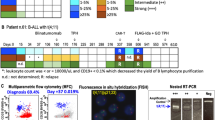Abstract
Objective: To detect the minimal residual diseases (MRD) in acute promyelocytic leukemia (APL) after complete remission (CR) and to analyze its clinical value in prognosis. Methods: Reverse transcription Polymerase chain reaction (RT/PCR) was used to detect MRD of patients with APL. Results: MRD positive rate in patients with APL was 92.8% (39/42) before treatment and 56.7 (21/37) immediately after the ATRA or chemotherapy-induced CR. Furthermore, MRD positive rate was related to the relapse in APL patients and could be considered as a marker to predict the relapse of patients with APL after CR. The MRD detection could also be applied to direct the consolidation therapy to prevent relapses. Conclusion: RT-PCR is valuable to monitor MRD and can be used as a marker to predict relapses.
Similar content being viewed by others
References
Baruchel A, Schaison G, Detection of minimal residual disease in leukemias[J]. Nouv Rev Fr Hematol 1990; 32: 21.
Hoelzer D, Thiel E, Loffer H, et al. Prognostic factors in a multicenter study for treatment of acute lymphoblastic leukemia in adults[J]. Blood 1988; 71: 123.
Nigrin RS, Blume KG. The use of polymerase chain reaction for the detection of minimal residual malignant disease[J]. Blood 1991; 78: 255.
Castaigne S, chomienne C, Daniel MT, et al. All-trans retinoic acid as a differentiation therapy for acute promyelocytic leukemia. I. Clinical results[J]. Blood 1990; 76: 1704.
Chen SJ, Chen Z, Chen A, et al. Occurrence of distinct PML-RARα fusion gene isoforms in patients with acute promyelocytic leukemia detected by reverse transcriptase/polymerase chain reaction[J]. Oncogene 1992; 7: 1223.
Pandlfi PP, Alcalay M, Fagioli M, et al. Genomic variability and alternative splicing generate multiple PML/RARα transcripts that encode aberrant PML proteins and PML/RARα isoforms in acute promyelocytic leukemia[J]. EMBO J 1992; 11: 1397.
Geng JP, Tong JH, Dong S, et al. Localization of the chromosome 15 breakpoints and expression of multiple PML/RARα transcripts in acute promyelocytic leukemia. A study of 28 Chinese patients[J]. Leukemia 1993; 7: 20.
Lococo F, Diverio D, Pandolfi PP, et al. Molecular evaluation of residual disease as a prodictor of relapse in acute promyelocytic leukemia[J]. Lancet 1992; 340: 1437.
Bennett JM, Catovsky d, Daniel MT, et al. Proposals for the classification of the acute leukemias. French-America-British (FAB) Coopration Group[J]. Br J Haematol 1976; 33: 451.
Wang ZY, Sun GL, Lu JX, et al. Treatment of acute promyelocytic leukemia with all-trans retinoic acid in China[J]. Nouv Rev Fr hematol 1999; 32: 34.
Chomezynski P, Sacchi N. Single-step method of RNA isolation by acid guanidinium thiocyanate-phenolchloroform extraction[J]. Anal Biochem 1987; 162: 156.
Viniou NA, Yataganas X, Stamatopoulos K, et al. Reverse transcription polymerase chain reaction for diagnosis and molecular monitoring of the PML-RARα fusion gene in acute promyelocytic leukemia[J]. Cancer Genet Cytogenet 1995; 84: 91.
Fenaux P, Chevret S, Guerci A, et al. Long-term follow-up conforms the benefit of all-trans retinoic acid in Acute promyelocytic leukemia. European APL group[J]. Leukemia 2000; 14: 1371.
Huang ME, Ye YC, Chen SR, et al. Use of all-trans retinoic acid in treatment of acute promyelocytic leukemia[J]. Blood 1988; 72: 567.
Huang W, Sun GL, Li XS, et al. Acute promyelocytic leukemia: Clinical relevance of two major PML- RARα isoforms detection of minimal residual disease by retrotranscriptase/polymerase chain reaction to predict relapse[J]. Blood 1993; 82: 1264.
Tobal K, Liu-yin JA, et al. RT-PCR method with increased sensitivity shows persistence of PML-RARα fusion transcripts in patients in log-term remission of APL[J]. Leukemia 1998; 12: 1349.
Author information
Authors and Affiliations
Corresponding author
Additional information
Foundation item: This work was supported by the Natural Science Foundation of Shandong Province (No. 2000.11) and a grant from the Science & Technology Committee of Shandong Province (No. 951228104).
Biography: Jiang Guo-sheng(1964–), male, Ph.D, associate professor, Department of Hemo-Oncology, Shandong Academy of Medical Sciences, majors in hematology and tumor-biology.
Rights and permissions
About this article
Cite this article
Jiang, Gs., Tang, Th., Bi, Kh. et al. Detection and its clinical value of minimal residual diseases in acute promyelocytic leukemia. Chin. J. Cancer Res. 14, 288–292 (2002). https://doi.org/10.1007/s11670-002-0063-y
Received:
Accepted:
Issue Date:
DOI: https://doi.org/10.1007/s11670-002-0063-y




